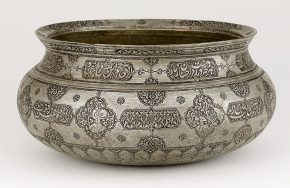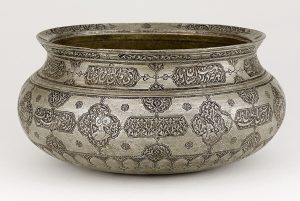17th Century Safavid bowl returned to the Embassy of Afghanistan in London

A very fine Safavid tinned copper bowl which had been looted from the National Museum of Afghanistan in Kabul was presented to the Embassy of Afghanistan in London for return to Kabul. The bowl, dating to the early 17th century, was lost during the civil war in Afghanistan in the 1990s. It was bought in good faith in December 1994 from an Afghan antique dealer in Jeddah (Saudi Arabia) by Patrick and Paola von Aulock who owned it for twenty years before deciding to sell it when they contacted Christie’s for a valuation. The bowl was identified by Sara Plumbly, Specialist and Head of Christie’s Islamic Art department as being a piece from the museum in Kabul. The bowl had been published in 1974 by Souren Melikian-Chirvani and was included in his catalogue of Islamic Metalwork from the Iranian World (Melikian-Chrivani 1982).
The bowl dates to the Safavid period (1501–1722), and includes a cartouche which mentions the owner’s name and date: ‘Owned by Mohammad Abū Tāleb 1013 [30 May 1604–18 May 1605]’. Three medallions depict scenes from the famous Persian tragic romance Khosrow and Shirin by the Persian poet Nizami Ganjavi (1141–1209) and the piece is sufficiently similar to another in the Musée de l’Homme in Paris that the two may come from the same workshop which was probably in the city of Herat. It appears the bowl had been very carefully mutilated in the past by engraving deep lines through each of the faces: this may have been at a moment when the Safavid dynasty was dethroned by the Afghan invasion in 1722 (Melikian-Chirvani 1982: 277). This defacement was not restricted to the human figures but also extended to the animals and was executed so carefully that it amounted to a subtle transformation of design rather than simple iconoclasm.
This bowl was scientifically analysed at the British Museum with the permission of the owners and the National Museum of Afghanistan. It shows that the bowl was manufactured by casting, with some additional working and use of a lathe for finishing. Analysis using surface X-ray fluorescence spectrometry confirmed that the bowl is largely of copper and the white metal plating is tinning. The decoration was engraved and was finely executed. A black material has been applied to the engraved design, which although it could not be firmly identified, is likely to be related to the organic black inlays seen on many brass bowls.

Back